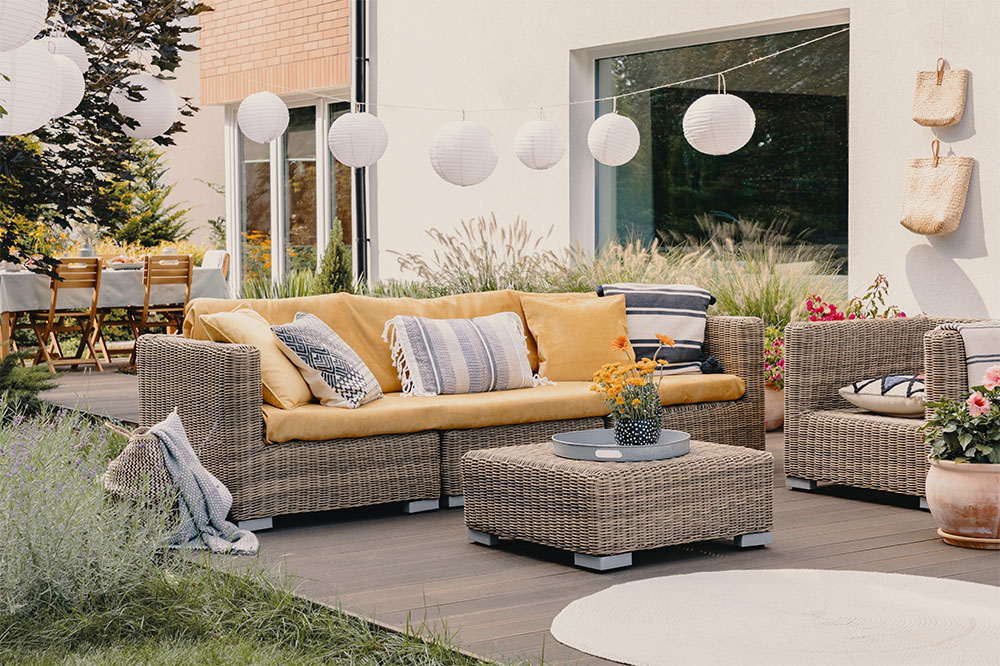Difference between yard and patio and ideas to decorate them
When planning outdoor living spaces, it’s important to distinguish between the yard and patio. The yard is the area in front of the house that can be used for gardening, growing veggies, playing ball, or even taking walks with the dog. The patio or deck is usually enclosed by a wall or fence and extends outward from the house. Let’s check out the difference between the two outdoor spaces and inspiring ideas to decorate them.
Ideas for a patio
Since a patio is a deck or porch located outdoors and is used for entertaining and enjoying the weather, a lot can be done with it depending on the seasons.

When decorating a patio, keep in mind the amount of space available. Some great ideas that work for most patios are:
- Paint the patio or deck a vibrant color
- Add brightly colored flowering plants
- Install a hammock
- Arrange potted plants in colorful containers around the patio
- Pick appropriate furniture
- String Christmas lights around the plants
Try opting for natural materials such as wood or stone for casual settings.
Ideas for a yard
Yard decorating is about creating an atmosphere that best suits the need, style, taste, and budget. Start by assessing the current condition of the yard. Remove any withered plants, dead trees, and weeds, and mow the lawn to get started. A neatly groomed lawn can still create a great impression even if it isn’t opulently made up. Overgrown grass can make the lawn look unkempt and unfinished. Mow the yard regularly using the correct mowing height to avoid excessive grass clippings that can lead to weed growth.
Most yards range in size from a tiny postage stamp to a sizeable lot. Knowing the exact usable space will help determine how much room is available for a seating area and how much for other uses.
Decorate with pieces that complement each other and fit the style of the house. Try going with a specific style or theme. This can help create a cohesive look for the entire yard without having to spend a lot of money on individual pieces. Choose furniture that is both sturdy and weatherproof. You can also set up a small home garden and utilize the space to grow vegetables and herbs.
Know what design suits each area
The yard will get different amounts of sunlight throughout the day and during different seasons. To make the most of its potential, plan which areas are best suited for sunbathing, and which are best for gardens or sitting in the shade.
Adding simple garden accessories such as benches, planters, or bird feeders can give the yard a lovely touch.
Tips on planting
Remember to plant early and often if using the yard to have a little home garden. Planting seasons are essential when it comes to yard work. Spring and summer are great times to plant flowers and vegetables, while fall and winter are good times for trees and shrubs. Plant according to the climate so that the plants will have the best chance of success.
Put the right plants in the right spots. Add low-maintenance plants that will add color and interest to the yard over time. Seasonal accents to the yard can give it a more polished look. Springtime features such as tulips and daffodils are beautiful additions, while fall foliage such as leaves and pumpkins can add a touch of beauty during the cooler months.
Think about water usage
When planning the yard, think about how water will be used most often –, particularly during planting and watering periods. Use containers that will hold more water, so there is less water requirement to irrigate or water frequently throughout the season.
If the yard or patio is small and mostly used for entertaining guests, consider investing in an outdoor dining set. These sets include chairs, tables, and umbrellas, making them ideal for group settings. They’re also often lightweight enough to be moved around easily.
Whether it’s a yard or a patio that the house has, this space is very versatile and can be used in the most ingenious ways. With umpteen choices for furniture, lighting, accessories, and even plants, there is no dearth of ideas to make the spaces into a useful, well-organized extension of the home.

